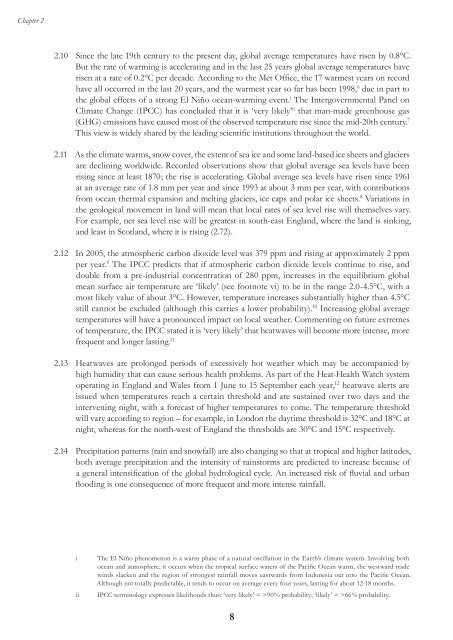Twenty-eighth Report Adapting Institutions to Climate Change Cm ...
Twenty-eighth Report Adapting Institutions to Climate Change Cm ...
Twenty-eighth Report Adapting Institutions to Climate Change Cm ...
Create successful ePaper yourself
Turn your PDF publications into a flip-book with our unique Google optimized e-Paper software.
Chapter 2<br />
2.10<br />
2.11<br />
2.12<br />
2.13<br />
2.14<br />
Since the late 19th century <strong>to</strong> the present day, global average temperatures have risen by 0.8°C.<br />
But the rate of warming is accelerating and in the last 25 years global average temperatures have<br />
risen at a rate of 0.2°C per decade. According <strong>to</strong> the Met Office, the 17 warmest years on record<br />
have all occurred in the last 20 years, and the warmest year so far has been 1998, 6 due in part <strong>to</strong><br />
the global effects of a strong El Niño ocean-warming event. i The Intergovernmental Panel on<br />
<strong>Climate</strong> <strong>Change</strong> (IPCC) has concluded that it is ‘very likely’ ii that man-made greenhouse gas<br />
(GHG) emissions have caused most of the observed temperature rise since the mid-20th century. 7<br />
This view is widely shared by the leading scientific institutions throughout the world.<br />
As the climate warms, snow cover, the extent of sea ice and some land-based ice sheets and glaciers<br />
are declining worldwide. Recorded observations show that global average sea levels have been<br />
rising since at least 1870; the rise is accelerating. Global average sea levels have risen since 1961<br />
at an average rate of 1.8 mm per year and since 1993 at about 3 mm per year, with contributions<br />
from ocean thermal expansion and melting glaciers, ice caps and polar ice sheets. 8 Variations in<br />
the geological movement in land will mean that local rates of sea level rise will themselves vary.<br />
For example, net sea level rise will be greatest in south-east England, where the land is sinking,<br />
and least in Scotland, where it is rising (2.72).<br />
In 2005, the atmospheric carbon dioxide level was 379 ppm and rising at approximately 2 ppm<br />
per year. 9 The IPCC predicts that if atmospheric carbon dioxide levels continue <strong>to</strong> rise, and<br />
double from a pre-industrial concentration of 280 ppm, increases in the equilibrium global<br />
mean surface air temperature are ‘likely’ (see footnote vi) <strong>to</strong> be in the range 2.0-4.5°C, with a<br />
most likely value of about 3°C. However, temperature increases substantially higher than 4.5°C<br />
still cannot be excluded (although this carries a lower probability). 10 Increasing global average<br />
temperatures will have a pronounced impact on local weather. Commenting on future extremes<br />
of temperature, the IPCC stated it is ‘very likely’ that heatwaves will become more intense, more<br />
frequent and longer lasting. 11<br />
Heatwaves are prolonged periods of excessively hot weather which may be accompanied by<br />
high humidity that can cause serious health problems. As part of the Heat-Health Watch system<br />
operating in England and Wales from 1 June <strong>to</strong> 15 September each year, 12 heatwave alerts are<br />
issued when temperatures reach a certain threshold and are sustained over two days and the<br />
intervening night, with a forecast of higher temperatures <strong>to</strong> come. The temperature threshold<br />
will vary according <strong>to</strong> region – for example, in London the daytime threshold is 32°C and 18°C at<br />
night, whereas for the north-west of England the thresholds are 30°C and 15°C respectively.<br />
Precipitation patterns (rain and snowfall) are also changing so that at tropical and higher latitudes,<br />
both average precipitation and the intensity of rains<strong>to</strong>rms are predicted <strong>to</strong> increase because of<br />
a general intensification of the global hydrological cycle. An increased risk of fluvial and urban<br />
flooding is one consequence of more frequent and more intense rainfall.<br />
i The El Niño phenomenon is a warm phase of a natural oscillation in the Earth’s climate system. Involving both<br />
ocean and atmosphere, it occurs when the tropical surface waters of the Pacific Ocean warm, the westward trade<br />
winds slacken and the region of strongest rainfall moves eastwards from Indonesia out in<strong>to</strong> the Pacific Ocean.<br />
Although not <strong>to</strong>tally predictable, it tends <strong>to</strong> occur on average every four years, lasting for about 12-18 months.<br />
ii IPCC terminology expresses likelihoods thus: ‘very likely’ = >90% probability; ‘likely’ = >66% probability.<br />
8
















